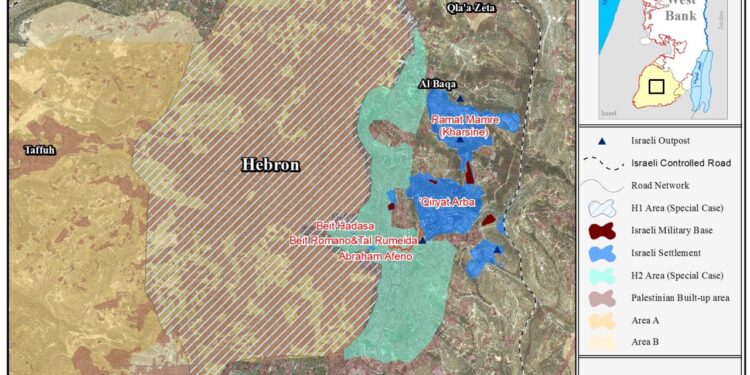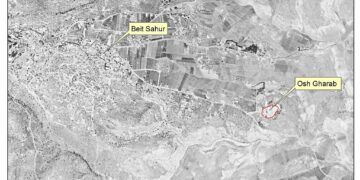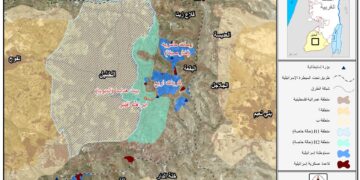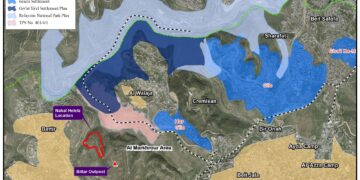Introduction
In a new provocative move, the Israeli occupation authorities have established a new settlement outpost in the heart of Hebron, specifically in Area (H1), which is under full Palestinian control according to the 1997 Hebron Agreement. This measure constitutes a blatant breach of signed agreements, a violation of international law, and a continuation of the policy of imposing facts on the ground through colonial settlement expansion. It will further entrench the siege imposed for more than 20 years, deepen the sense of injustice and exclusion among Palestinians, elevate social tensions, and fuel further escalation between Palestinians and Israeli settlers.
The 1997 Hebron Agreement
The agreement stipulated the division of the city into two areas:
- (H1): Under full control of the Palestinian Authority, covering most of the city’s neighborhoods.
- (H2): Under Israeli security control, including the settlers and the areas surrounding the Ibrahimi Mosque.
According to the agreement and Israeli military orders, settlers are prohibited from entering Area (H1) except in exceptional cases. Over the past two decades, the occupation has imposed severe restrictions on the residents of Tel Rumeida, including limitations and outright bans on Palestinian vehicle movement, closure of entrances, the establishment of checkpoints, and strict daily entry and exit restrictions ending at 9:00 p.m.
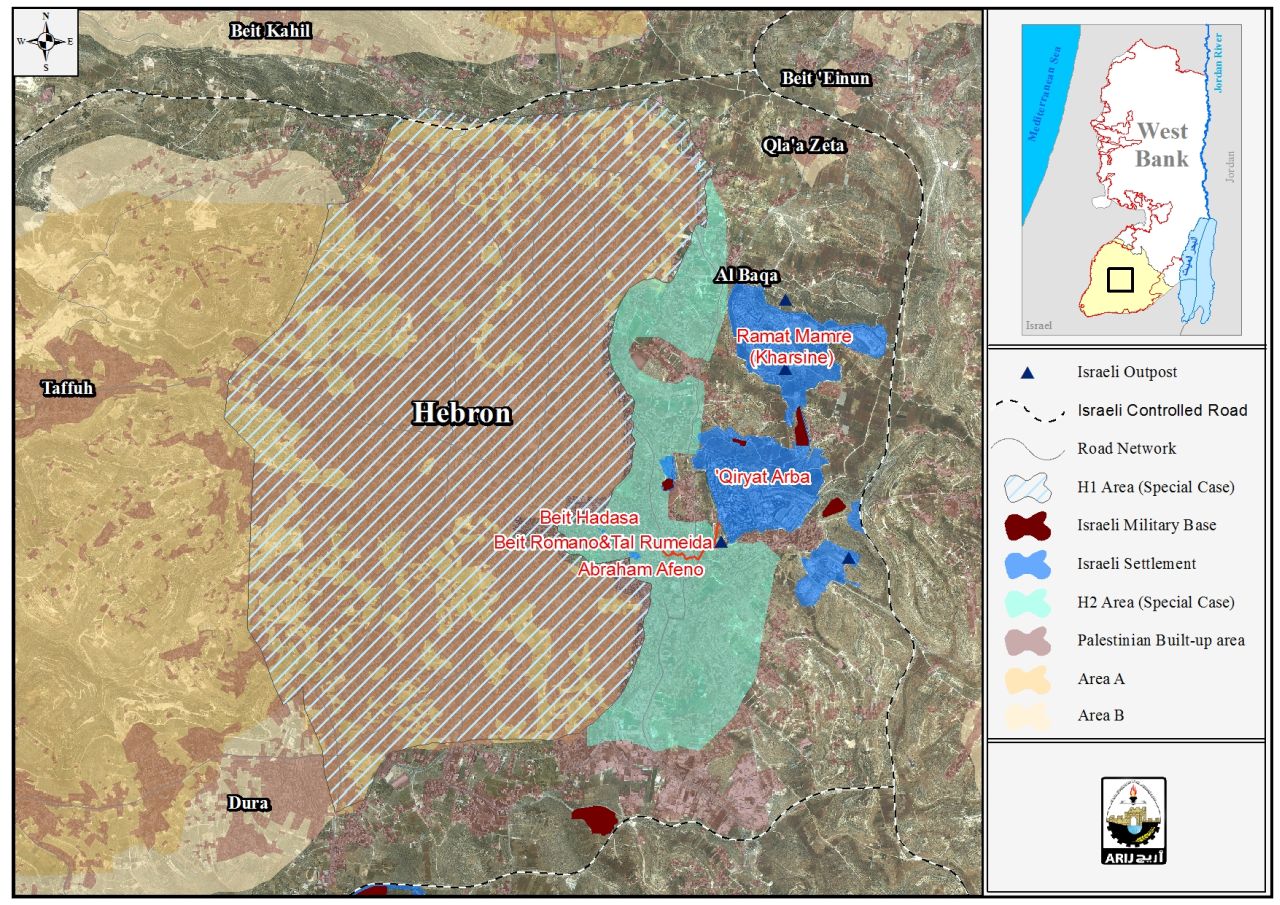 Recent Developments in Tel Rumeida
Recent Developments in Tel Rumeida
At the beginning of 2025, settlement attacks in the targeted area escalated. In March, settlers stormed and took over the Tamimi family home, claiming to have purchased parts of it, and established a new settlement named “Gaon Yehuda Quarter”, reflecting a policy of forcibly imposing settlement facts. In parallel, two new caravans were placed at the start of the year on privately owned Palestinian land (plot no. 37), located in a sensitive spot between a mosque and a girls’ high school west of the Jewish cemetery; an intentionally provocative choice that heightens friction with Palestinian residents. Additionally, the head of the Antiquities Unit in the “Civil Administration” launched new excavations with a directed agenda aimed at expanding a settlement tourism project, despite the land privately owned by Palestinians. This confirms the use of archaeological narratives as a tool to legitimize settlement expansion and land confiscation, reflecting an integrated system of policies designed to entrench settlement control and alter the geographic, demographic and cultural character of the area.
The New Settlement and Its Location
The new settlement is built on a strategically located piece of land, which settlers claim was Jewish-owned prior to 1948, granting the project symbolic and political dimensions beyond mere spatial control. The situation is further aggravated by the land’s direct proximity to a mosque and a Palestinian school, making daily friction almost inevitable. Since the caravans were placed on the site, one of the entrances to the mosque and school has been closed, negatively affecting students, worshippers, and local residents, and increasing their sense of isolation and restriction. Furthermore, the emerging settlement is detached from existing settlement clusters, meaning its protection will require additional military reinforcements, resulting in further security measures imposed on Palestinians, thereby increasing their daily suffering. This reflects how each new settlement project becomes a tool for reshaping the geographic and demographic landscape at the expense of Palestinian presence.
Legal and Political Dimensions
The construction of the new settlement in the heart of Hebron carries grave legal, political, and security implications. Legally, the project is a clear violation of the Hebron Agreement, as the settlement lies within Area (H1), which was to remain under full Palestinian control. It also explicitly contradicts existing Israeli military orders, including one in place for over two decades prohibiting settlers from entering this area. Moreover, the move constitutes a direct violation of international law:
- Article 49 of the Fourth Geneva Convention (1949) prohibits an occupying power from transferring its civilian population into occupied territory.
- UN Security Council Resolution 2334 (2016) unequivocally reaffirms the illegality of settlements, considering them an obstacle to peace.
Politically and from a security perspective, this settlement undermines the peace process and signals Israel’s unwillingness to honor agreements or revive negotiations. It inflames tensions within Hebron by implanting a new settlement outpost in the heart of Palestinian neighborhoods. Additionally, the project poses security challenges even for Israel itself. It will require deploying extra forces to protect the settlement, expand the security regime, and increase the long-term cost of occupation, thereby bolstering instability.
Conclusion
The establishment of the new settlement in Area (H1), in the heart of Hebron, cannot be seen as a mere expansion but as a deeply consequential step with legal, political, security, and social dimensions. It represents a blatant violation of international agreements, a direct challenge to international law, and a serious blow to peace efforts. Situated in an area that, under the Hebron Agreement, should remain under full Palestinian control, this settlement is a dangerous provocation that undermines any prospects for a political solution, threatens the social fabric and daily life of Palestinians in Tel Rumeida, and escalates tensions with implications for the entire West Bank.
In light of these repercussions, confronting this settlement project requires action across multiple parallel tracks:
- International Pressure: Calling on the international community, especially the signatories to the Oslo and Hebron Agreements, to exert real pressure on Israel to halt the project immediately.
- Legal Accountability: Activating legal mechanisms through recourse to the International Court of Justice and the International Criminal Court to expose these violations and hold perpetrators accountable.
- Local Resilience: Strengthening the resilience of Tel Rumeida residents through material and moral support, and systematically documenting violations to affirm the Palestinian narrative.
- Diplomatic and Media Campaign: Launching a wide-scale diplomatic and media campaign to highlight the dangers of what is happening in Hebron as a serious test of the ability of international humanitarian law to protect occupied peoples.
Prepared by:
The Applied Research Institute – Jerusalem


